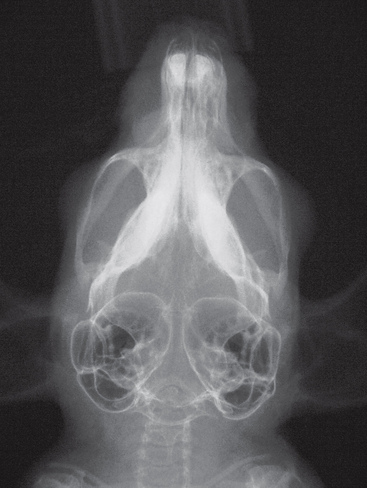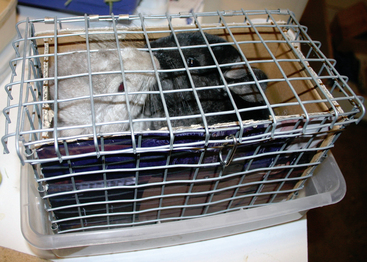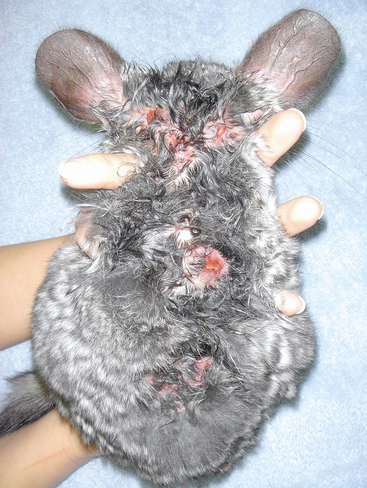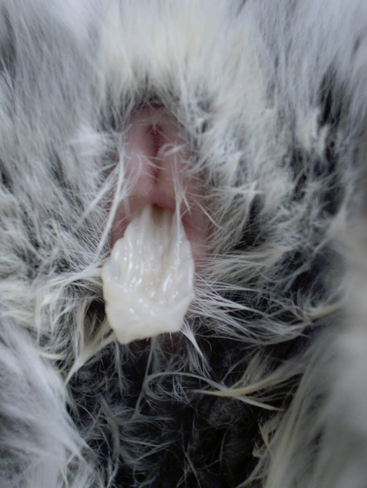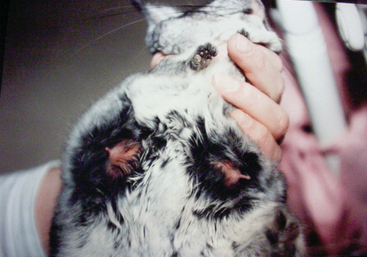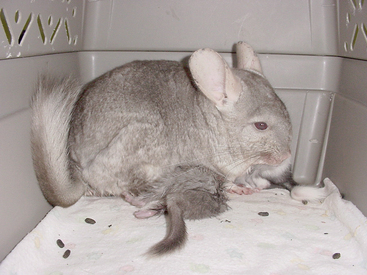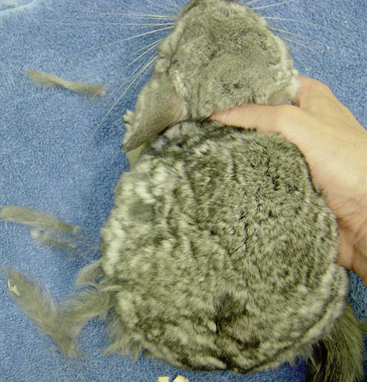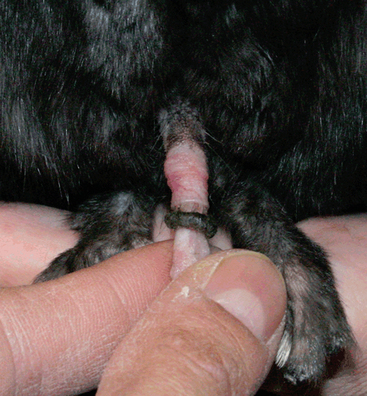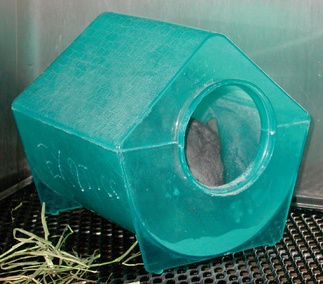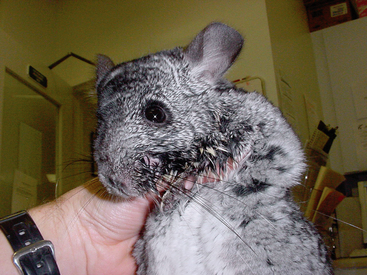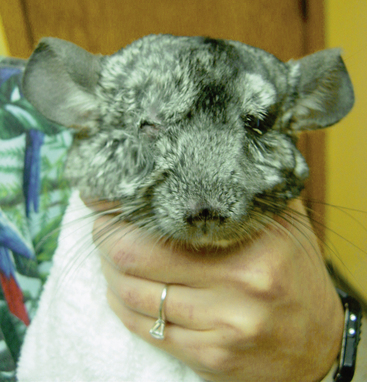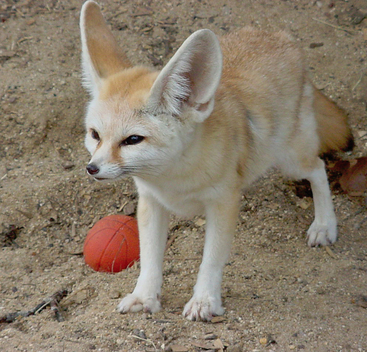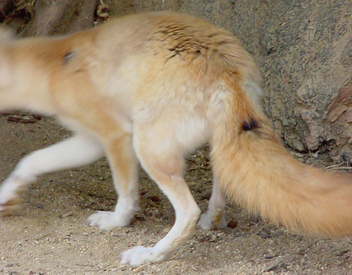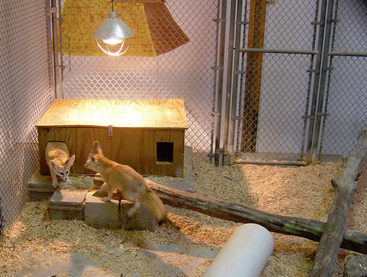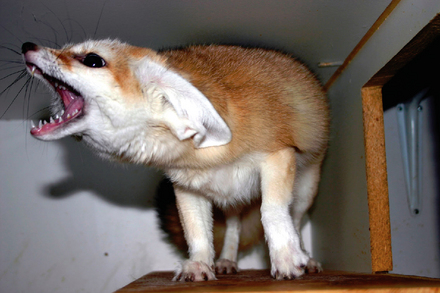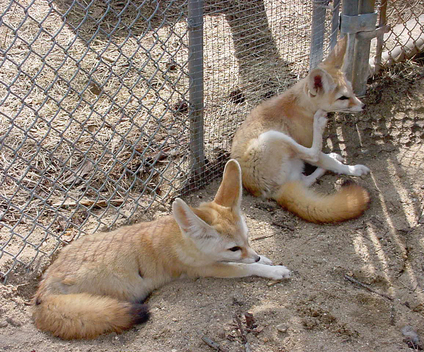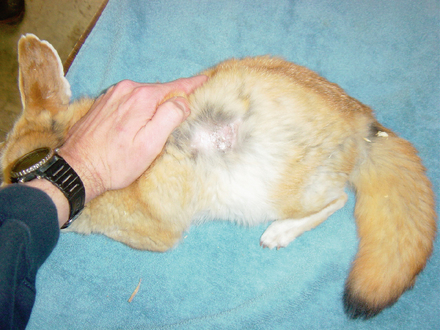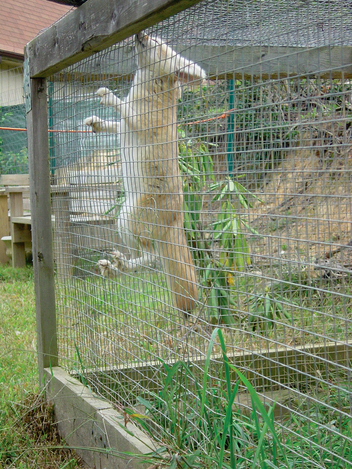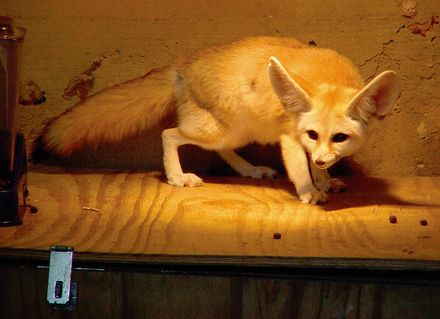CHAPTER 7 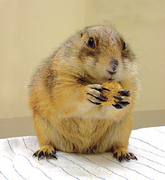 MISCELLANEOUS SMALL MAMMAL BEHAVIOR
MISCELLANEOUS SMALL MAMMAL BEHAVIOR
Chinchillas
Natural History and Behavior
The family Chinchillidae is made up of three genera consisting of six species. Two species of chinchilla are recognized: Chinchilla brevicaudata and Chinchilla lanigera. The species kept in captivity is C. lanigera; the status of this species in the wild is considered to be highly endangered, and the species is listed in Appendix I of the CITES treaty.
C. lanigera is native to the Andes mountain ranges of Northern Chile. These chinchillas live in crevices and holes among the rocks on the relatively barren slopes at elevations of 3000 to 5000 m (900 to 16,000 ft).24
Chinchillas are primarily crepuscular and nocturnal but can also be active in the daytime45 and do not hibernate.24 They sit erect to eat, using their forepaws. Their natural diet of grasses, cactus fruit, leaves, and bark is fibrous and low in energy. Chinchillas live in colonies of up to 100 individuals and are naturally very social creatures. They may live up to 10 and even 20 years.
Sensory Behaviors
Chinchillas have large ears and enormous auditory bullae. The behavioral hearing range of chinchillas resembles that of humans,8,22 so they are often used in hearing research (Figure 7-1). Chinchillas are sensitive to noise and startle easily. In spite of this, chinchillas acclimate to familiar sounds and will sleep during their daytime resting period, even with the stimulus of people in the environment. Chinchillas will quickly rouse if disturbed by unfamiliar sounds, however, and when so alerted to potential danger, they stand on their hind limbs and may react with a warning cry.
Chinchillas are largely nocturnal and use their vibrissae to find their way in darkness.24 Their eyes are large and black with a vertical, slit pupil. Chinchillas are sensitive to light and should ideally get 12 hours of darkness per night and undisturbed rest during the daytime. Chinchillas are sensitive to heat above 26° C (80° F).8 This may be one reason that they tend to dislike being held.
Chinchillas will use their mouths to explore their environment. They are curious about their surroundings, and will investigate the entire home. They normally chew on the cage and furnishings. Potential hazards (e.g., electrical cords) need to be addressed before chinchillas are allowed to exercise outside of their cage. A chinchilla may give a trial bite to the handler’s finger. This is normal exploratory behavior but can be painful nonetheless.
Communicative Behaviors
Chinchillas are generally quiet. Normal communication among members of a group is by soft, high-pitched grunting noises.52 Chinchillas “bark” if they are angry or defensive and “honk” for attention (e.g., if lonely or wanting a treat). Their warning cry is a whistling sound.50
Social and Antisocial Behaviors
Chinchillas are generally social and can be housed as pairs, single-sex groups, or polygynous units (one male per two to six females).38 Social groupings are preferred in captivity; however, single housing may be necessary to prevent aggression. Aggression is most common during initial introduction and breeding (Figure 7-2). If pet chinchillas are singly housed, they need substantial human interaction for social enrichment.
Chinchillas can be territorial and will aggressively defend against intruders (Figure 7-3). Anecdotally, female chinchillas are more territorial than males, and some may defend their territory by positioning themselves vertically on the cage and spraying urine in an upward stream, directed at the intruder. Some males also attempt to engage in this behavior.
When new chinchillas are introduced, barking, chasing, and biting are common. Chinchillas are capable of inflicting severe and fatal injuries on one another. When attempting to kill another chinchilla, the aggressor typically gets on top of the victim, pins it down, and bites it on the back and the neck. New introductions should be attempted only after caging animals near each other for at least 1 week. When pairing chinchillas for breeding, the female should be placed into the male’s cage so that she is in new territory.
An alternative method involves closely confining the two chinchillas to a cage sufficiently small enough so that they are barely able to turn around, in order to prevent fighting via crowding. This is commonly referred to as the “smoosh” method by laypersons and fanciers.50 A strong-smelling substance (e.g., camphor) is first applied to both chinchillas, and they are smooshed together for approximately 15 minutes. Then both chinchillas are placed in a new, larger cage (one that is neutral territory for both of them) containing two dust baths. Both chinchillas will typically begin to bathe immediately, in a furious attempt to remove the odor-causing substance. By the time they are clean the pair will no longer tend to fight.50 Always provide small houses for each chinchilla to escape to that can be defended to prevent attacks (see Female Reproductive Behaviors).
Reproductive Behaviors
Male Reproductive Behaviors
Fighting will occur between two males if they are housed in the same cage with a female, and it may also occur if they are in close proximity to females in heat. Males can remain with the female during gestation and parturition and will participate in the care of the young.
Female Reproductive Behaviors
A female may initially reject a male’s advances and then later accept him. Mating usually occurs several times during the night. A loss of some fur from the female is normal during mating, but excessive fur slip may indicate the need to separate the pair. Mated females will have an ejaculatory plug in their vaginal opening (Figure 7-4). This will be expelled within days of breeding, and although it is much larger than the estrus plug, it is rarely found.
Females are seasonally polyestrous from November to May.24,38 A vaginal closure membrane is open during estrus, making the opening between the urethral papilla and anus slightly moist and easily visualized.24 The estrous cycle for chinchillas is approximately 28 days, and a postpartum estrus occurs. Gestation is 105 to 115 days, 110 days average. Parturition generally occurs at night or in the early morning, and litter size averages two to three; however, chinchillas can have up to six kits. Females do not usually make a nest.24
Chinchillas deliver one uterine horn at a time, and the two horns can go up to an hour between deliveries. The strenuous phase of labor usually lasts 1 to 2 hours or less. During that time the female writhes and stretches, and she may vocalize as if in pain.50 The female will continually lick her vent as each fetus emerges, and she will normally help to deliver each baby using her teeth. Therefore, breach or difficult labor may result in fetal trauma. Minor laceration, amputation, or death of the newborn may result. The mother’s face may therefore be bloody after labor. Chinchillas are placentophagic, and dystocia is uncommon58; however, cesarean section should be undertaken if more than 4 hours of unproductive labor is observed.24 After labor the female should be palpated to be sure no feti have been retained; mummified fetuses are relatively common.
Females have two pair of lateral thoracic and one pair of inguinal mammary glands (Figure 7-5). Chinchillas sit on top of their babies to nurse them and keep them warm (Figure 7-6). Kits tend to develop a preference for one teat and may become territorial over it. They are capable of fighting and inflicting injury or even death to one another from the time they are born. For litters of three or more, rotating kits out of the cage may be necessary in order to prevent sibling rivalries. To reduce the risk of mastitis and uterine infections, females and their kits should not be allowed to dust bathe for the first 10 days after parturition.
Newborn chinchillas are born fully furred with a complete set of teeth, and their eyes will open within 24 hours.38 They are very vocal, and they normally make a continuous whimpering sound50 and can be very aggressive toward one another.38 This behavior is normal and does not indicate a problem. Weaning can occur as early as 6 weeks of age, although lactation can last up to 8 weeks. The kits are able to eat solids from birth.24 Both male and female chinchillas tend to their young, and a group of chinchillas may communally raise their young. In the pet trade, chinchillas are separated from their mothers at 7 to 8 weeks of age; if orphaned they can be weaned at as early as 3 weeks.38 They are usually sold at 3 to 6 months of age.
Eating Behaviors
Chinchillas are monogastric hindgut fermenting herbivores. They are also reported to eat insects on occasion.28 Chinchillas normally sit upright on their haunches to eat, and hold food with their forefeet. They mainly eat at night, ingesting more than 70% of their daily intake during the evening.58 Gastrointestinal transit time is 12 to 15 hours.58 Chinchillas are coprophagic, and, like other small herbivores, chinchillas do not regurgitate or vomit.
An adult chinchilla should consume approximately 1 ounce of chinchilla pellets, one teaspoon of vegetables, and free choice hay each day.38 Dietary changes should be made gradually, as abrupt changes in diet can result in anorexia and gastrointestinal stasis. Treat foods should be fed sparingly, and those containing high starches and sugars avoided. Dark green leafy vegetables can be fed instead of other, less-appropriate treats.
Elimination Behaviors
Chinchillas tend to urinate in the same place but do not practice site-specific elimination for feces. They produce very little odor. Fecal pellets dry quickly and are easy to clean up, and chinchillas produce relatively little urine. Fecal excretion occurs mainly at night, when most of the food is ingested.58 Cecotropes are consumed in the mornings.23
Male and female chinchillas will attempt to urinate on intruders; females are more accurate at a close range (see Social and Antisocial Behaviors). Targeted urination can be aimed at the clinician attempting to remove the animal from a carrier or the hospital cage. Lack of fecal pellet production and reduction of fecal pellet size are major indicators of anorexia and gastrointestinal stasis. Lack of feces is often misdiagnosed as constipation by clients and veterinarians alike.
Locomotor Behaviors and Activities
Chinchillas are most active in the evening and in partial light conditions. This is when the most accurate assessment of their behavior can be made. Chinchillas are also very athletic and agile. They like to jump and climb and so should be provided with multilevel cages.24 They can jump over 6 feet high (one of our clients has watched her chinchilla jump to the top of her refrigerator from a dead standstill on several occasions). They have no fear of heights, and their active nature frequently leads to injuries, especially of the caudal extremities. They tend to get their delicate legs caught in cage wire, air conditioning return vents, and so on. The radius, ulna and/or tibia are the bones most often affected. Most fractures respond well to either splinting or external fixation. If amputation becomes necessary, chinchillas respond well if analgesics are used judiciously.
Grooming Behaviors
Known for their soft, dense hair coat, chinchillas have approximately 60 hairs per follicle, which are loosely attached.24 Like other small mammals, they are fastidious groomers. Lack of grooming usually indicates medical problems.
As previously noted, a predator defense mechanism in chinchillas is to lose large patches of fur to free themselves in the event of a struggle, and gentle handling is necessary in order to prevent this loss, known as “fur slip”(Figure 7-7). If this should happen during an examination, clients should be warned that it could take up to 6 to 8 weeks for this hair to grow back and several more months before the hair will appear completely normal.58
Adult males are susceptible to accumulations of fur inside the prepuce. So-called “hair rings” or “fur rings” can result in constricting damage to the penis and can be fatal if they become severe (Figure 7-8). These constrictions may occur repeatedly in stud males in a breeding situation.45 Males routinely groom their penises and also masturbate in the same manner (see Male Reproductive Behaviors). Both males and females will groom, care for, and clean their young. Chinchillas are fastidiously clean and have little odor. Fur chewing is abnormal and may have many causes (see Medical Implications of Abnormal Behaviors).
Chinchillas require dust bathing in Fuller’s earth every 24 to 72 hours (Figure 7-9). If the animal does not have access to a dust bath, the fur will become matted with oily secretions. Unlimited access to dust baths has led to conjunctivitis and dry skin. The dust bath should be provided in a dishpan or aquarium outside of the chinchilla’s enclosure so that it is not overused or defecated in. The recommended exposure to the dust bath is approximately 5 minutes per day. Excess hair may be removed by brushing with a canine “slicker” brush. Their nails do not generally require trimming, and ectoparasites are uncommon but can be treated as in other small mammalian herbivores.
Medical Implications of Abnormal Behaviors
Like most small exotic mammals, chinchillas are stoic and do not display abnormal behaviors until disease is relatively advanced. Sick chinchillas are less active and less vocal than their healthy counterparts. They exhibit dyspnea only when respiratory disease is severe. Because chinchillas are obligate nasal breathers, dyspnea is an advanced presentation of respiratory compromise. Illness from any cause may result in depression, anorexia, and weight loss. Sick chinchillas generally groom less, have an unkempt appearance, and may have a soiled vent when ill.
Hypersalivation and anorexia are common signs of dental malocclusion in chinchillas (Figure 7-10). Affected animals may go to food and pick it up but have extreme difficulty eating. They may drop the food item, and then repeat the process many times, indicating a desire to eat but an inability to do so. Also called “slobbers,” the clinical signs of malocclusion or dental infection may include wet chin, face, chest, and forepaws; weight loss; dysphagia; halitosis; and loss of appetite. Sedation is usually necessary for a thorough dental examination and treatment. It is imperative that the clinician have the proper dental specula for small mammals to ensure safe, complete, oral examination. Use of a rigid endoscope is recommended, as visualization of all tooth surfaces is limited without one. Tooth root elongation, a relatively common problem, may be evident only on skull radiographs.24
Hypersalivation can also be associated with heat stress. Chinchillas originate from the dry, cool, Andes mountain region of South America. Prolonged exposure to temperatures above 80° F (26° C) can result in heat stress and even death.58 High humidity adds to heat stress. Symptoms of overheating include hypersalivation (wet chin, paws, and chest), recumbency, panting, cyanosis, hyperthermia, and death. Gastrointestinal stasis and anorexia are very common after an episode of hyperthermia.
Fur chewing may result from stress caused by noise (e.g., a dog barking, construction, home repairs), overcrowding, hormonal imbalance, excessive handling, or drastic changes in routine. Affected animals will chew from their shoulders backward and may also barber their cagemates. Fur chewing may also have a hereditary component. In the chinchilla fur industry, fur chewing has an incidence as high as 15% to 20%. It generally develops in both genders at 6 to 8 months of age.62 Chinchillas with fur-chewing behaviors also have been shown to have adrenal and skin histopathologic changes consistent with hyperadrenocorticism.62
Repetitive movements such as racing back and forth on the bottom of the cage may be a sign that the cage is too small or does not have enough perching platforms for jumping behavior. Epiphora or blepharospasm may indicate corneal abrasion, ocular foreign body, conjunctivitis, or tooth root problems (Figure 7-11).
Chinchillas are extremely sensitive to perceived threats. Loud noises and sudden changes in the normal routine are stressful. The visual contact, noises, and odors associated with predatory species will cause stress; therefore chinchillas should not be caged near dogs, cats, ferrets, or large birds. Birds and cats should never be allowed up onto a chinchilla’s cage to sit or perch. Minor veterinary procedures such as blood collection can usually be accomplished with manual restraint (e.g., wrapping in a towel and holding at the base of the tail with the rest of the body supported).
How Behavior Relates to Captivity
Chinchillas are easy to handle, and they rarely bite; however, they are active and move very quickly. Hold the patient gently around the thorax with one hand and cradle the rump with the other hand. Alternatively, as previously described, the tail can be held at the base as long as the body is supported. If the dense fur is handled roughly, “fur slip” may result.
Acknowledgments
Client Education Handout: Chinchilla (Chinchilla lanigera)
Biologic Facts
Behavior
Diet
Housing
Common Medical Conditions Requiring Veterinary Attention
Fennec Foxes
Natural History and Behavior
The fennec fox (Fennecus zerda or Vulpes zerda) lives in the Sahara desert region of North Africa, from Morocco and Niger to Egypt and Sudan. Two reports of sightings have been recorded from the Middle East, one from Kuwait and the other from the Sinai.59 In these desert and subdesert habitats fennecs are usually found in sandy areas, where they occupy a permanent den several meters long that they dig themselves. Fennec foxes are the smallest canid, weighing 1 to 1.5 kg (2 to 3 lb) and are primarily nocturnal. Their omnivorous diet includes plant material, small rodents, birds, eggs, lizards, and insects.52
Fennec foxes exhibit many unique physiologic adaptations to desert life. Fennec metabolism functions at only 67% of the rate predicted for an animal its size.47 Similarly, resting heart rate is only 118 beats per minute (bpm), 40% lower than would be expected, and the respiratory rate at rest is 23 breaths per minute. Their normal body temperature is 38.2° C (100.8° F). Fennec foxes shiver when the ambient temperature drops below 20° C (68° F).49
As air temperature rises, the fennec radiates body heat by dilating blood vessels in its feet and large, vascular ears. Fennec foxes start to pant only when the temperature exceeds 35° C (95° F), and the jaws open to a full pant only at 38° C (100° F).49 They reduce water loss by not sweating until body temperature rises to 40.9° C (105.6° F), and when they pant fennecs curl the tongue to minimize the loss of saliva.47 Panting rates of up to 690 breaths per minute have been observed.49
Sensory Behaviors
Fennec foxes are largely dependent on hearing for predation. They have exceedingly large tympanic bullae and the biggest ears relative to body size in the canid family, measuring up to 15 cm (6 in) in length and constituting 20% of the body surface area (Figure 7-12).47 Fennec foxes are mostly nocturnal and have a well-developed tapetum lucidum.
Communicative Behaviors
As with other canids, scent-marking appears to play a prominent role in chemical communication among fennec foxes. They have paired anal sacs on both sides of the anus that coat feces with scent and can be evacuated voluntarily. The caudal gland is a black spot that is covered with bristles and is located proximally on the tail (Figure 7-13). Glands are located between the toes, as well. Fennec foxes will also urine-mark their territory.
Fennec foxes are generally quiet and do not draw attention to themselves. However, they use a variety of vocalizations to communicate. They will whine, growl, snarl, and bark in the same manner and context as small domestic dogs. The ears are held sideways if the animal is angry or upset, and backward with aggression or biting. Squeaking occurs as part of a greeting ceremony directed toward other foxes or human keepers. They emit a similar scream when they are happy or excited (e.g., when carrying a favorite toy and running with it). Fennec foxes will also emit a scream if they are distressed (e.g., if stared at intensely or if cornered or threatened). A howl-scream may accompany reproductive activities. When they are content, purring may be observed. This behavior is unique to fennec foxes and kit foxes.1,59
Social and Antisocial Behaviors
Fennec foxes are more social than other fox species. Although they hunt alone in the wild, fennec foxes live in colonies of up to 10 individuals. Their basic social unit is a mated pair and their offspring (Figure 7-14). In the wild, fennec foxes commonly sleep and rest while lying in contact with or on top of one another. A group of fennec foxes may engage in play behavior such as mock fighting and chasing games. Fights are accompanied by screaming, hip slamming, and pushing with extended forelimbs.
Fennec foxes can be taught to retrieve, which provides exercise. They often entertain themselves by throwing, stalking, and pouncing on small dog and cat toys. When approached by a keeper or another member of their group a fennec fox normally cowers and lies on its side, yelping, wagging its tail, and grimacing in a typical canine greeting display, just as in the wild (Figure 7-15). Although fennec foxes are mostly nocturnal, they are also active during the day and enjoy basking in the sun (Figure 7-16). Those that are hand-raised and imprinted on humans are generally tame and more suitable as pets than parent-raised babies.
Captive fennec foxes are extremely predatory by nature. Fennec foxes are capable of killing animals much larger than themselves, and they will attempt to take down “prey” many times their size (e.g., fawn, rabbit).50,59 They tolerate predator species (e.g., dog, adult cat, and skunk), but they should not be trusted with other animals. They can and will inflict a painful bite.
Reproductive Behaviors
Fennec foxes are unusual among wild canids in that the female, referred to as the “vixen,” is seasonally polyestrous.1,59 If the first litter is lost, a second may be produced 2½ to 3 months later. Breeding pairs are monogamous and will peacefully coexist year round. In captivity, mating occurs during January and February. The male, referred to as the “reynard,” will urine-mark his territory during this period, and the female may develop dorsolateral alopecia.20,32 Females stay in heat for 1 to 2 days. Mating is accompanied by vocalization and concludes with a copulatory tie that lasts up to 2 hours. The gestation period for fennec foxes ranges from 49 to 63 days (average is 51 days).
Fennec foxes are very nervous and aggressive during breeding and rearing. Breeding pens must be large and supplied with adequate hiding places to provide the parents with privacy and security. If the parents are disturbed, the mother may attempt to move the litter or cannibalize them. To prevent neonatal deaths, avoid disturbances until the kits reach 3 to 4 weeks of age and provide supplemental heat in the den.
Female Reproductive Behaviors
Females are in heat for approximately 2 days. During courtship the female flags her tail horizontally to one side. For successful breeding the female must be allowed uninterrupted visual, auditory, and olfactory contact with other fennecs, indicating the degree of their social nature.59 The young are born in late winter to early spring, and the female becomes aggressive and defends her nest site during this time.
Experimentally, contraception in fennec fox females has been achieved by using the gonadotropin-releasing hormone (GnRH) analogue deslorelin.5
Eating Behaviors
The fennec fox has the same dental formula as the domestic dog (I3/3, C1/1, PM4/4, M2/3). Compared with other vulpines, their canines are reduced and their teeth are sharply cuspidate, which may facilitate insectivory.59 The diet of fennecs in the wild includes plant material, fruits, small rodents (gerbils, jerboas), birds, eggs, lizards, and insects (locusts). Digging for plant roots (tubers, bulbs) is an important source of moisture.
Laboratory studies suggest that fennec foxes can survive indefinitely without access to free water,52,59 however, they will drink freely if water is available. Fresh water should be provided at all times.
Fennec foxes kill prey using a neck bite and normally eat prey beginning at the head.3 They tend to carry bits of food away from the bowl to a quiet area to be consumed, then return for more and repeat the process until the bowl is empty. They will sometimes attempt to bury food, even in plain sight such as in the middle of the floor or on a couch or a bed. Fennec foxes obtain some of their food in the wild by digging, so pronounced scratching and raking occurs at the time of eating in captivity. In a group setting, food jealousy is common. Skirmishes for food among fennecs normally escalate into back-arched threat displays and fighting. Fennecs should be fed in the evening when they are most active.
Elimination Behaviors
Fennec foxes practice site-specific defecation in the wild. If a suitable substrate is provided, they will eliminate in a shallow depression they have scraped with their feet, and cover the spot by pushing litter with the nose or hind feet.3,59 They may learn to use a litter box in captivity; however, attempts to train them are met with varying success. Because of their digging habits, a covered litter box with regular clay litter is recommended. Avoid clumping litter, as this will stick to their fur and nose. Anecdotal reports suggest that fennec foxes will also soil the house as a sign of displeasure or unhappiness.
Locomotor Behaviors
The soles of a fennec fox’s feet are covered with fur, protecting them from heat and enabling them to run in loose sand. They dig so rapidly that they have earned a reputation for being able to sink into the earth, although digging can lead to eye injuries. Fennec foxes are able to jump 60 to 70 cm (2 to 2.5 ft) high from a standing position and can leap 120 cm (4 ft) horizontally.47 They are extremely agile and fast moving. Their heavily furred tail (sometimes referred to as a “sweep”) helps the fox to change direction quickly and keeps the fox’s nose and feet warm when it curls up to sleep.
Grooming Behaviors
Dorsolateral alopecia often occurs in females at the time of breeding (Figure 7-17). Bilaterally symmetric patches of alopecia with scale and hyperpigmentation can also appear on the flanks. The cause is uncertain. Differentials include mounting trauma from a male and endocrine effects, but the condition could also signify undiagnosed skin pathology.
How Behavior Relates to Captivity
Fennec foxes should be kenneled while unsupervised. A large, multilevel ferret or cat cage with shelves makes a suitable crate. They can easily climb out of fenced enclosures (Figure 7-18). If fennec foxes are kept outdoors, cages should be designed so that occupants cannot dig out or otherwise escape. The enclosure should be placed in a low humidity, well-ventilated environment. They have a strong instinct to dig and should be provided a soft cage substrate for burrowing. Dusty cage substrates should be avoided. Putting a collar with a bell on it may help owners to avoid accidentally stepping on the fox and aid in locating it when it is free in the house.
Fennec foxes can be trained to walk on a harness or leash but are unreliable and can slip out of these if they are startled. If a fennec escapes, recapture is difficult. Transport in a carrier or kennel is strongly recommended. They are able to jump up onto countertops and get into cabinets. Baby latches may be necessary in order to protect them from poisons and other household hazards. Fennec foxes may be illegal in some states.
Fennecs are unusual among foxes in that they are highly social. They need the socialization and companionship of other fennecs or people, dogs, and cats as surrogates. The ideal social grouping for fennec foxes is a mated pair. Owners must be cautioned that a fennec fox will attack other animals it perceives as prey. Conversely, the fennec is small and may be unsuitable as a companion for large breed dogs (Figure 7-19). Fennec foxes usually have little odor, although they have anal sacs similar to those in domestic dogs that are not routinely removed.
Acknowledgments
Client Education Handout: Fennec Fox (Fennecus zerda)
